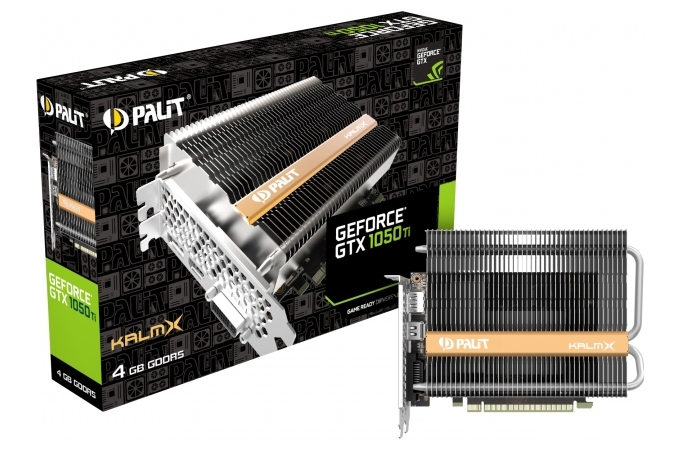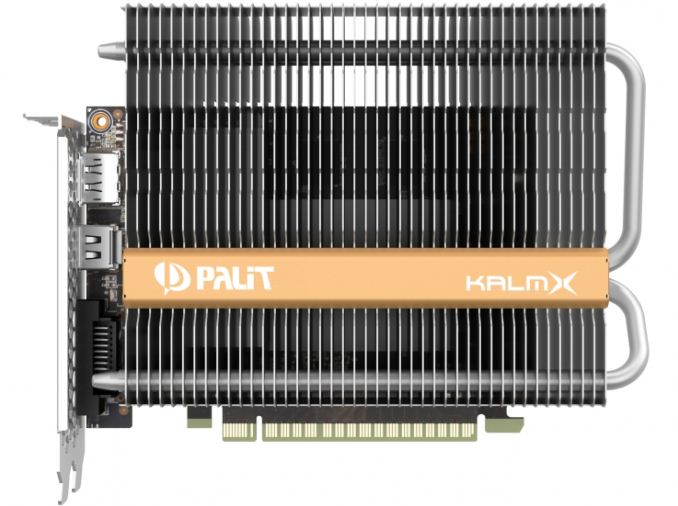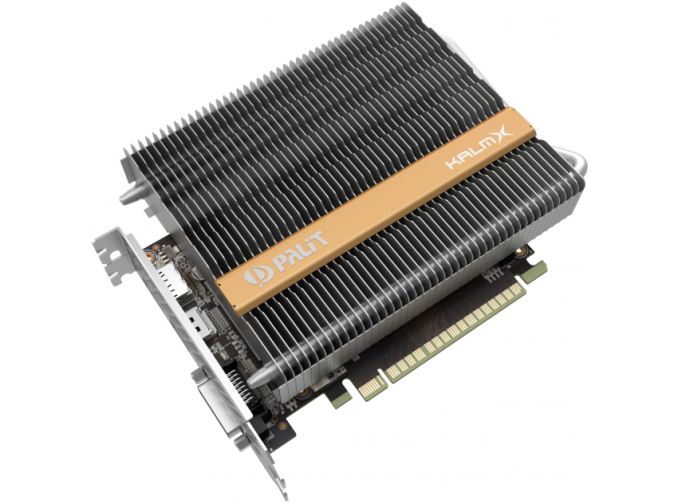Palit Announces KalmX: A Passively-Cooled GeForce GTX 1050 Ti Graphics Card
by Anton Shilov on February 7, 2017 6:00 PM EST
Palit has quietly launched a passively-cooled graphics card based on NVIDIA’s GeForce GTX 1050 Ti GPU. The sizeable board uses a large aluminum heatsink with heat pipes and requires substantial height clearance in a case. Meanwhile, its indisputable trump card is a lack of any noise.
Producers of graphics cards nowadays tend to differentiate from each other by using different cooling systems and increasing performance of their products by boosting GPU frequencies beyond the recommendations of GPU developers. Modern high-end graphics cards use coolers with two or even three fans with a low rotation speed to reduce noise levels, but it is hard to find a passively-cooled graphics board that produces no noise at all. Palit decided to go head first into this and developed a video card with a passive cooler featuring a contemporary GPU powered by NVIDIA’s Pascal architecture under the brand KalmX.
The Palit GeForce GTX 1050 Ti KalmX uses a unique PCB design and has a dual-slot aluminum heatsink that features two heat pipes. The card runs at reference frequencies (1290/1392 MHz base/boost for the GP107 GPU) and is equipped with 4 GB of GDDR5 memory operating at 7000 MT/s. The board does not require any additional power connectors as it consumes no more than 75 W, but its cooler is large and may not fit into some compact computers. As for connectivity, the board features an HDMI 2.0b output, a DisplayPort 1.4 as well as a dual-link DVI-D header.
Palit did not announce MSRP of the GeForce GTX 1050 Ti KalmX and it is unclear whether the producer plans to charge a premium versus NVIDIA’s MSPR for the GTX 1050 Ti ($139) for passive cooling. At press time, one of Amazon’s partners was selling Palit’s passively-cooled GeForce GTX 750 Ti KalmxX Silent 2 GB for $238, but such overprice is not common. If we get updated pricing, we'll update this news.
Related Reading:
Source: Palit


















24 Comments
View All Comments
Ro_Ja - Sunday, February 12, 2017 - link
True but you'd want a passive heatsink all over the graphics card if you're gonna cool this thing down.cygnus1 - Tuesday, February 7, 2017 - link
Not really passive if the requirements include a case fan.hojnikb - Wednesday, February 8, 2017 - link
Exactly. What good is a PASSIVE card, if it needs a goor airflow. Might as well put a 12cm fan on it and call it a day.torp - Wednesday, February 8, 2017 - link
Any passive cooling solution relies on having *some* airflow. Really low power systems can get away with convection, but that's still airflow. Personally I'd rather control the flow with case fans that I have 100% control over than rely on the manufacturer's decisions about fan speed.Of course, I'm in the tiny minority that actually builds systems that are silent under load. I'm buying one of these as soon as it's available in my area.
SharpEars - Wednesday, February 8, 2017 - link
Could not have said it better myself. The hot air from the heat-sink has to go somewhere. The good thing about this card is that the small noise GPU fans are absent and can be replaced with much larger case fans that cool the entire internals of the PC.zodiacfml - Saturday, February 11, 2017 - link
I am thinking the same thing. I was skeptical with passive cooling products before but the good value with them is they mostly have huge heatsinks where a good airflow or large, slow moving fan will work wonders.cygnus1 - Wednesday, February 8, 2017 - link
You kind of caught my point. Maybe other fanless cards have the same listed requirement and I've just never noticed it. But this one specifically lists a case fan as a requirement, which to me means they believe that no form of passive/convection cooled case will provide enough airflow for this card.DanNeely - Wednesday, February 8, 2017 - link
No, it means at least some pure passive setups won't be able to handle it. It's just like speccing PSU recommendations enormously large vs actual need; to avoid warranty claims they need to spec against the worst case.An ~20W probably can get away with no extra fan all the time even in a very cramped case. 75W OTOH either needs good very good passive/convective ventilation or a decent fan somewhere else in the case.
sonicmerlin - Sunday, February 12, 2017 - link
What about this? http://www.anandtech.com/show/10925/calyos-nsg-cub...eldakka - Wednesday, February 8, 2017 - link
"Palit has quietly launched a passively-cooled graphics card..."I see what you did there.